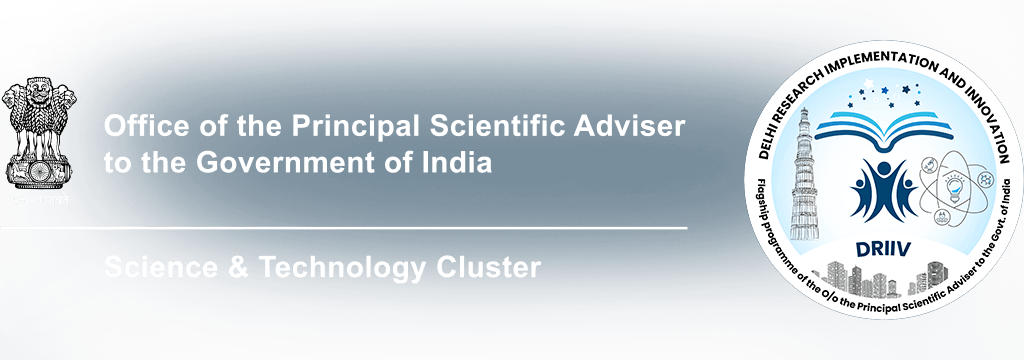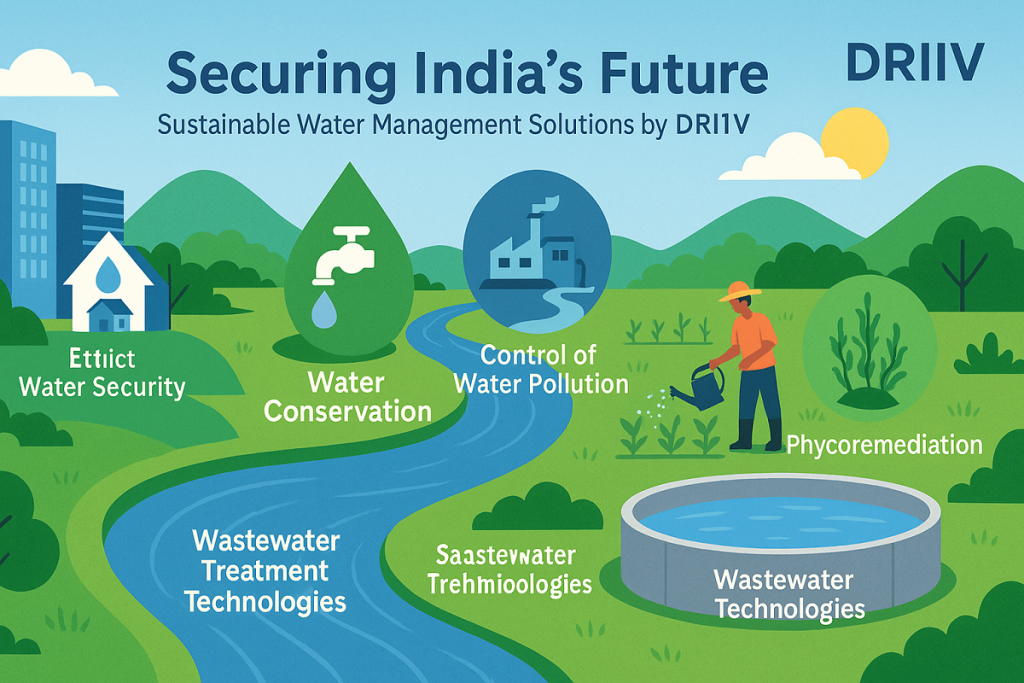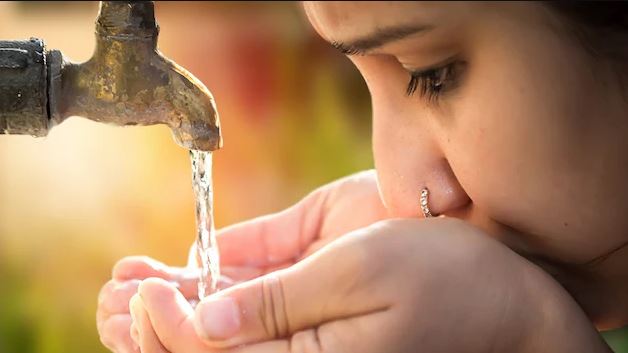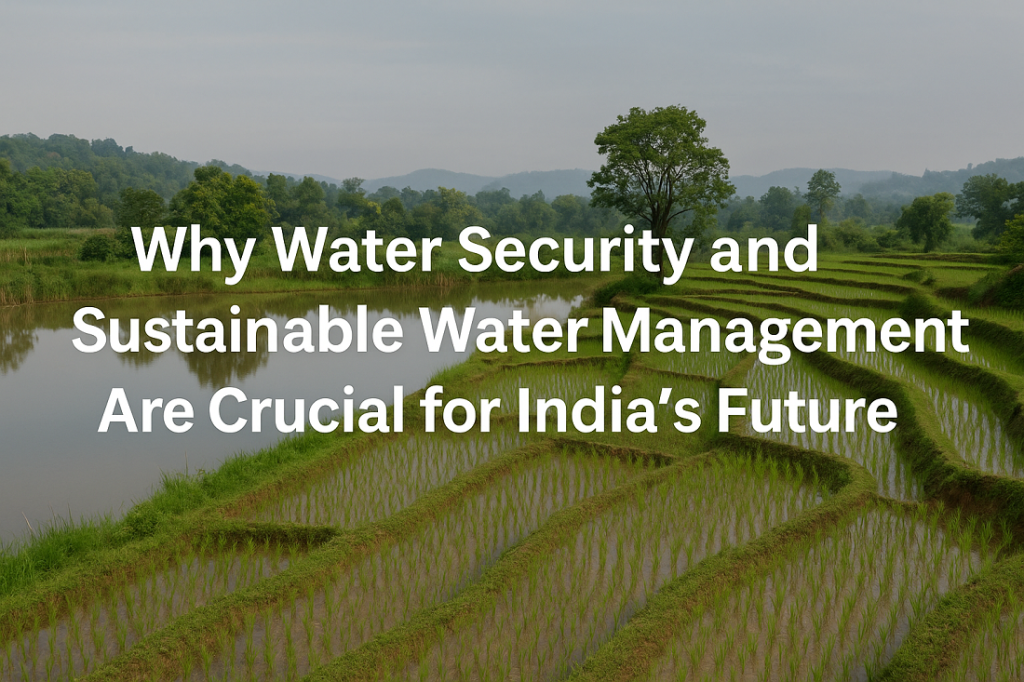Access to clean water is one of the most basic needs of any nation. In India, where rapid urbanization and climate change are putting enormous stress on water resources, water security is no longer just a goal—it’s a necessity. At DRIIV, we are committed to creating impactful solutions that ensure water security in India through innovation, collaboration, and sustainable technologies.
This blog explores how sustainable water management, water conservation, control of water pollution, and advanced methods like Phycoremediation and Wastewater Treatment Technologies are transforming India’s water future.
What is Water Security?
Water security means ensuring there is enough clean, safe, and accessible water for all—today and in the future. It includes protection against water-related disasters, pollution, and scarcity. In India, this means addressing the increasing demand for water while protecting the quality and sustainability of water sources.
Why is Water Security in India a Priority?
India is home to 18% of the world’s population but has only 4% of the world’s freshwater resources. As agriculture, industry, and domestic usage grow, the stress on water systems has become severe.
Challenges to water security in India include:
- Over-extraction of groundwater
- Pollution from industries and households
- Poor wastewater treatment infrastructure
- Climate change impacting rainfall patterns
- Lack of awareness and policy implementation
- These issues make it urgent to adopt innovative, scalable, and green technologies.
Sustainable Water Management: A Smart Solution
Sustainable water management means using water resources efficiently and responsibly without damaging ecosystems. It involves:
Protecting natural water bodies
- Recycling and reusing wastewater
- Improving water infrastructure
- Involving communities in conservation
- Using technology to monitor and optimize usage
At DRIIV, we support sustainable solutions that balance ecological preservation with human needs.
Water Conservation: Small Efforts, Big Impact
Water conservation is the foundation of water security. Saving water reduces stress on rivers, lakes, and underground reserves.
Here’s how water conservation practices can help:
- Rainwater harvesting in homes, buildings, and farms
- Fixing leaks and using low-flow taps and toilets
- Drip irrigation and mulching in agriculture
- Educating communities about mindful water usage
DRIIV promotes awareness programs and technologies that encourage smart water usage at every level—urban, rural, and industrial.
Control of Water Pollution: Cleaning the Flow
Polluted water harms human health, aquatic life, and agricultural output. Effective control of water pollution is key to improving both quality and availability.
Major pollutants include:
- Industrial waste
- Agricultural runoff (pesticides and fertilizers)
- Household sewage
- Plastics and other solid waste
- To address this, DRIIV collaborates with tech innovators and public bodies to:
- Install real-time water quality monitoring systems
- Develop affordable filtration solutions
- Encourage green chemistry practices in industries
Phycoremediation: Nature’s Way to Clean Water
One of the most promising solutions we support at DRIIV is Phycoremediation. This is a green, cost-effective method of using algae to treat polluted water.
How Phycoremediation Works:
Algae absorb harmful nutrients and toxins (like nitrogen, phosphorus, heavy metals) from wastewater.
They produce oxygen, supporting healthy aquatic life.
Algae biomass can be used further—for biofuels, fertilizers, and more.
Benefits of Phycoremediation:
- Low energy requirement
- Eco-friendly and sustainable
- Scalable for urban and rural areas
- Minimal operational cost
Phycoremediation is ideal for restoring polluted lakes, ponds, and even industrial wastewater streams.
Wastewater Treatment Technologies: Turning Waste into a Resource
India generates over 61,000 million liters of wastewater daily, but only about one-third is treated. Modern Wastewater Treatment Technologies are essential to recycle water for reuse.
Technologies Supported by DRIIV:
Membrane Bioreactors (MBRs): Combine filtration and biological treatment for high-quality effluent.
Sequencing Batch Reactors (SBRs): Flexible, low-footprint systems suitable for urban spaces.
Constructed Wetlands: Nature-inspired systems that filter water using plants and soil microbes.
Decentralized Treatment Plants (DTPs): Localized systems ideal for housing societies and institutions.
These technologies not only reduce freshwater demand but also make treated water usable for irrigation, industrial cooling, and even flushing.
DRIIV’s Role in Water Security for India
At DRIIV, our mission is to foster innovation and scale solutions that impact sustainability. In the field of water security, we:
- Support R&D startups working on affordable and scalable water tech
- Partner with government bodies for pilot projects
- Promote community engagement through awareness campaigns
- Facilitate the transfer of technology from labs to real-world applications
Through our Science and Technology (S&T) cluster approach, we bring together researchers, entrepreneurs, investors, and policymakers to build a water-secure India.
Case Studies: Impact Stories from DRIIV
1. Reviving Polluted Lakes in Delhi NCR
Using Phycoremediation, algae-based water treatment systems restored oxygen levels and biodiversity in urban lakes, transforming them into community assets.
2. School-Level Water Recycling Units
With Wastewater Treatment Technologies, schools now recycle greywater for toilets and gardening—saving thousands of liters every week.
3. Industry-Water Partnerships
Partnered with industrial units to treat and reuse wastewater in cooling and processing cycles, significantly reducing freshwater withdrawal.
Future Outlook: Smart Water, Safe Future
India’s future depends on how we manage and conserve water today. With climate challenges growing, the need for sustainable water management will become even more critical.
Emerging trends include:
- AI & IoT for water usage optimization
- Smart sensors for leak detection and real-time quality monitoring
- Blockchain for transparent water data management
- DRIIV is actively exploring and supporting these next-gen solutions.
Conclusion
Water security in India is a collective responsibility. Government, industry, research institutions, and citizens must work together. With cutting-edge solutions like Phycoremediation, Wastewater Treatment Technologies, and simple yet effective water conservation strategies, we can protect our precious water resources.
At DRIIV, we are proud to be a driving force behind sustainable innovations that ensure a greener, cleaner, and more water-secure India.
FAQs
1. What is water security, and why is it important?
Water security means having reliable access to clean and safe water for all needs. It’s crucial for health, agriculture, economy, and environmental balance.
2. What are the main challenges to water security in India?
India faces issues like overuse of groundwater, pollution, poor infrastructure, and climate change, all of which threaten water availability and quality.
3. How does Phycoremediation help with water treatment?
Phycoremediation uses algae to naturally clean polluted water by absorbing toxins and nutrients, making it an eco-friendly and low-cost method.
4. What are some sustainable water management techniques?
Techniques include rainwater harvesting, water recycling, smart irrigation, leak detection, and public awareness campaigns.
5. How is DRIIV contributing to water conservation and pollution control?
DRIIV supports innovation through startups, R&D projects, and collaborations. We focus on scalable and nature-based solutions like Phycoremediation and modern wastewater treatment.




